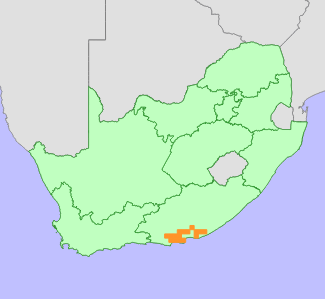|
Scientific Name | Protea foliosa Rourke |
Higher Classification | Dicotyledons |
Family | PROTEACEAE |
Synonyms | Protea tenax (Salisb.) R.Br. var. latifolia Meisn. |
Common Names | Leafy Sugarbush (e) |
National Status |
Status and Criteria | Least Concern |
Assessment Date | 2019/05/27 |
Assessor(s) | A.G. Rebelo, H. Mtshali & L. von Staden |
Justification | Protea foliosa is endemic to the mountains of the Eastern Cape Province, South Africa. It has an extent of occurrence (EOO) of 9750 km² and is recorded from 54 subpopulations with many more unsurveyed subpopulations suspected to occur. It is a locally abundant species. The threat of alien invasive plants is increasing in the western parts of its range, and may lead to a population decline if left unmanaged. Currently the population is suspected to be stable and this species is listed as Least Concern. |
Distribution |
Endemism | South African endemic |
Provincial distribution | Eastern Cape |
Range | It occurs from Elandsberg to Port Elizabeth, Riebeek East to Grahamstown, in the Eastern Cape Province, South Africa. |
Habitat and Ecology |
Major system | Terrestrial |
Major habitats | Loerie Conglomerate Fynbos, Algoa Sandstone Fynbos, Kouga Grassy Sandstone Fynbos, Kouga Sandstone Fynbos, Suurberg Quartzite Fynbos, Grahamstown Grassland Thicket |
Description | This species grows in sandstone and quartzite soils, 100-1000 m. It is long-lived, and survives fires by resprouting from underground boles or rootstocks. Wind-dispersed seeds are stored in fire-resistant inflorescences, and released after fires. It is pollinated by birds and insects. |
Threats |
| Subpopulations in Port Elizabeth have lost habitat to urban development, and in Otterford and Longmore there has been loss to timber plantations. The plantations are however no longer expanding, and therefore this threat has largely ceased. However, alien invasive plants, particularly pine seedlings continue to spread and increase in density in Van Staden's and near Longmore State Forest. Despite these threats, the majority of the population occurs in mountainous areas where there are no severe threats. |
Population |
This species occurs as scattered plants, and it is locally abundant in moist areas. The majority of subpopulations are large. Only four subpopulations are small and isolated, with less than 100 plants each. There are at least 54 known subpopulations, and while some loss has taken place in the past the population is not suspected to be currently declining.
|
Population trend | Stable |
Assessment History |
Taxon assessed |
Status and Criteria |
Citation/Red List version | | Protea foliosa Rourke | Least Concern | Raimondo et al. (2009) | |
Bibliography |
Goldblatt, P. and Manning, J.C. 2000. Cape Plants: A conspectus of the Cape Flora of South Africa. Strelitzia 9. National Botanical Institute, Cape Town.
Manning, J.C. and Goldblatt, P. 2012. Plants of the Greater Cape Floristic Region 1: The Core Cape Flora. Strelitzia 29. South African National Biodiversity Institute, Pretoria.
Raimondo, D., von Staden, L., Foden, W., Victor, J.E., Helme, N.A., Turner, R.C., Kamundi, D.A. and Manyama, P.A. 2009. Red List of South African Plants. Strelitzia 25. South African National Biodiversity Institute, Pretoria.
Rebelo, T. 2001. Sasol Proteas: A field guide to the proteas of southern Africa. (2nd ed.). Fernwood Press, Vlaeberg, Cape Town.
|
Citation |
| Rebelo, A.G., Mtshali, H. & von Staden, L. 2019. Protea foliosa Rourke. National Assessment: Red List of South African Plants version 2024.1. Accessed on 2025/12/02 |
 Comment on this assessment
Comment on this assessment

